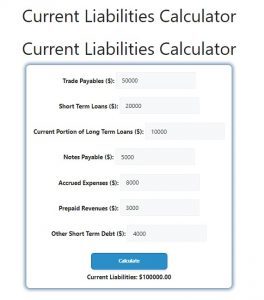Current Liabilities Calculator
About Current Liabilities Calculator (Formula)
A Current Liabilities Calculator is a crucial tool for businesses and individuals alike, helping to assess short-term financial obligations. Current liabilities are debts or obligations that are due within one year, and understanding these is essential for maintaining a healthy financial status. By using this calculator, users can gain insights into their immediate financial responsibilities, enabling better planning and decision-making.
Formula
The formula for calculating current liabilities (L) is:
L = Total Payables (TP) + Short-Term Loans (STL) + Current Portion of Long-Term Debt (CPLTL) + Notes Payable (NP) + Accrued Expenses (AE) + Payroll Reserves (PR) + Short-Term Debt (STD).
How to Use
- Gather Data: Collect information regarding all short-term financial obligations, including total payables, loans, notes payable, and other relevant expenses.
- Input Values: Enter each of the collected values into the respective categories of the calculator.
- Calculate: Use the calculator to compute the total current liabilities by applying the formula.
- Analyze Results: Review the calculated current liabilities to understand your short-term financial obligations and how they impact your overall financial health.
Example
Suppose a company has the following short-term liabilities:
- Total Payables (TP): $50,000
- Short-Term Loans (STL): $20,000
- Current Portion of Long-Term Debt (CPLTL): $10,000
- Notes Payable (NP): $5,000
- Accrued Expenses (AE): $8,000
- Payroll Reserves (PR): $3,000
- Short-Term Debt (STD): $4,000
Using the formula:
L = 50,000 + 20,000 + 10,000 + 5,000 + 8,000 + 3,000 + 4,000
L = $100,000
In this example, the total current liabilities amount to $100,000, indicating the company’s obligations due within the year.

FAQs
- What are current liabilities?
Current liabilities are obligations that a company needs to settle within one year, such as accounts payable, short-term loans, and other debts. - Why is it important to calculate current liabilities?
Calculating current liabilities helps assess a company’s short-term financial health and ability to meet its obligations. - What is included in total payables?
Total payables include all amounts due to suppliers and creditors, such as invoices and bills that are yet to be paid. - What is the current portion of long-term debt?
This refers to the amount of long-term debt that is due within the next year, which must be paid off in the short term. - How often should I calculate current liabilities?
It is advisable to calculate current liabilities regularly, especially during financial planning or budgeting sessions. - Can personal expenses be considered current liabilities?
Yes, personal obligations such as credit card debt and short-term loans can also be treated as current liabilities. - What happens if current liabilities exceed current assets?
If current liabilities exceed current assets, it may indicate liquidity issues, suggesting that a company may struggle to meet its short-term obligations. - How do you manage high current liabilities?
High current liabilities can be managed by reducing expenses, increasing cash flow, or refinancing short-term debts to longer terms. - Is the Current Liabilities Calculator suitable for individuals?
Yes, individuals can also use the calculator to manage personal debts and financial obligations effectively. - What is the difference between current and long-term liabilities?
Current liabilities are due within one year, while long-term liabilities are obligations that extend beyond one year. - How does current liabilities affect financial ratios?
Current liabilities are a key component in calculating liquidity ratios such as the current ratio and quick ratio, which assess financial health. - What should be the ideal current ratio?
A current ratio of 1.5 to 2 is generally considered healthy, indicating that current assets are sufficient to cover current liabilities. - Can I use this calculator for a business plan?
Yes, calculating current liabilities is crucial for creating a solid business plan and forecasting future financial health. - What documents do I need to calculate current liabilities?
You will need financial statements, invoices, and any records of debts or obligations that need to be settled. - What role do accrued expenses play in current liabilities?
Accrued expenses represent costs that have been incurred but not yet paid, contributing to the total current liabilities. - How can I reduce my current liabilities?
You can reduce current liabilities by paying off debts, negotiating better payment terms, and avoiding unnecessary short-term loans. - Are taxes considered current liabilities?
Yes, taxes owed within the year are classified as current liabilities. - Can current liabilities impact credit ratings?
Yes, high levels of current liabilities relative to assets can negatively impact credit ratings and borrowing ability. - Is it possible to have zero current liabilities?
Yes, a company or individual can have zero current liabilities if all obligations are paid off and there are no debts due. - How does the Current Liabilities Calculator assist in budgeting?
By understanding current liabilities, users can better allocate resources, plan for cash flow needs, and make informed financial decisions.
Conclusion
The Current Liabilities Calculator is a powerful tool for both businesses and individuals to assess their short-term financial obligations. By understanding and managing current liabilities, users can improve their financial planning and decision-making processes. Regularly calculating current liabilities helps ensure that you can meet your financial commitments and maintain a healthy financial position.